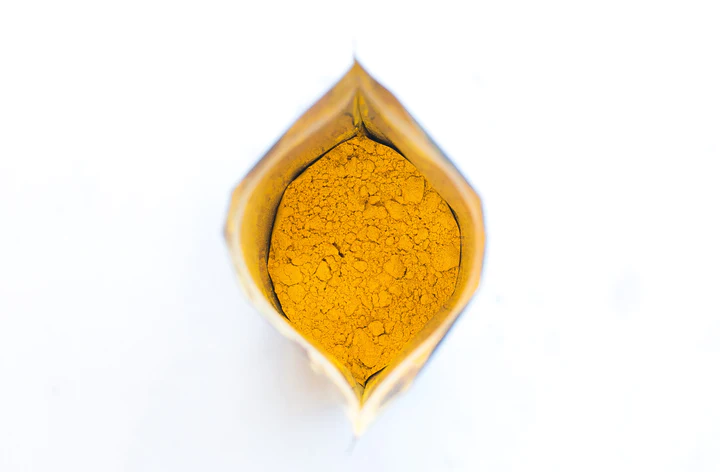What does turmeric actually do?
With so much attention being drawn to turmeric, it’s likely you’ve heard something about its wonderful health benefits, or you’re Doctor may have advised you to start taking curcumin tablets for inflammation. As can be the case, it is easy to be confused by advertising and mass messaging about what turmeric actually is, how to take it and what it may do for you. With a lot of brands flooding the market and jumping on the turmeric ‘bandwagon’, we thought we’d break down the basics of what turmeric is and what to look for when purchasing a product with curcumin as an active ingredient.
What is turmeric?
Turmeric scientifically named Curcuma Longa (it’s part of the Ginger family) is a beautiful bright yellow spice most commonly grown in parts of Asia and tropical climates. The turmeric plant, whilst being stunning to look at, provides limited health benefits with a root that grows below the soil being the primary part harvested due its diverse functionality. With a rich history stemming from both Ayurveda and Chinese medicines, turmeric has long been celebrated (some records showing use 5000 years ago) for its bountiful health benefits and traditional medicinal properties.
What’s the difference between turmeric root, turmeric powder and turmeric oil?
Turmeric root (rhizome) is the hard ginger like structure that grows beneath the ground. This root contains as many as 100 compounds including; moisture, omega 3 fatty acids, alpha linolenic acid, dietary fibres and lots of minerals like calcium, potassium, phosphorous, sodium, iron and vitamins B and C. The glorious rhizome is then split giving us two main products; turmeric oil and turmeric power.
Turmeric oil maintains the liquid of the root along with several compounds and is responsible for the aroma of the spice.
Turmeric powder contains most of the curcuminoids. Curcuminoids are the components that offer the bright yellow colour to the turmeric root and studied for a wide spread health benefits. Curcumin, demethoxycurcumin and bisdemethoxycurcumin are the 3 main curcuminoids we hear about and have been the centre of a lot of scientific research.
What’s the difference between turmeric and curcumin? Which should I take?
Curcumin only typically makes up 3-6% of turmeric powder. When studied in isolation, it’s results have some trusting benefits including helping regulate inflammation and cancer cell proliferation just to name a few. From these results, scientists and pharmacologists started introducing the concept of extracting curcumin and producing high concentrate tablets and formulations of the compound to maximise these benefits.
More recently, research into turmeric root as a whole is showing that the other compounds in the radicle also play an important role, independently and when paired with curcumin. For instance, high doses of pure curcumin may have very limited ability to be absorbed within the body and thus, make it difficult to gauge how much of this nutrient is being utilised in the body. It is now being considered that natural compounds within the turmeric root can enhance the absorption of curcumin therefore a more complete dose containing these aiding molecules will maximise bioavailability of curcumin. The challenge however is that some of these compounds are generally lost in the extraction and purification process of curcumin.
From all the analysis to date, the suggestion would be to stay true to the turmeric plant by following a preparation process favoured by natural medicine with thousands of years of practise by creating a more nutritionally complete product comprising of both curcumin and a variety of its natural compounds. When consumed in this form the nutrients come together synergistically in the body showcasing the powerhouse of health benefits that Turmeric has.
What are the main health benefits and claims associated with turmeric?
What is known and proven to date and what you can trust is that turmeric can aid digestion, help support healthy liver function, act as a strong antioxidant, stimulate contractions of the gallbladder, help aid the symptomatic relief of dysmenorrhea (TCM) and help relieve mild rheumatic joint pain (Ayuervedic).
A limited amount of studies have shown promising results in aiding the management of ailments such as chronic inflammation, cancer prevention, treatment of depression, immune regulation, pain relief, skin disease, bone disease and various others creating a focus point for research to come.
How can I increase my chances of getting the benefits?
Natural turmeric powder has low bioavailability, indeed most of the turmeric ingested is not absorbed by the intestines. Concentrated curcumin is even less so and rarely do we see high serum levels from capsules or tables ingested. However, one thing that is know is that when 20mg of piperine (a wonderful molecule found inside black pepper) was added to curcumin the bioavailability increased by 2000%.
In addition to this, turmeric is a fat soluble molecule. Without being too scientific, this suggests that for it to be carried more efficiently around the blood and cross over into the cells, it is advised that fat molecules are to be consumed at the same time. Hence, turmeric is often suggested taking with a fatty milk, oil, cream or yoghurt.
How much do I need?
Most of the research is done with around 2-6g of turmeric powder taken daily over a period of time, although there is currently no specific recommended daily intake. As more conclusive studies are completed, we will learn more as the exact amount and format we should focus on consuming. For the time being, always start with less, suggestion around 2g per day of pure turmeric powder to check your stomach and gallbladder is comfortable with the dose. For your peace of mind, high levels (up to 10g per day) have been tested to be safe but this is probably not necessary long term to take.
Take home messages
- Always opt for good quality organic turmeric powder because there can be imitators out there (filling with bulk agents, sugars and metals).
- Ensure there is enough turmeric in a serving and enough black pepper to be having an effect and maximising absorption.
- Try taking with meals or a drink with a fatty nut milk.
- Start with small dose and increase gradually. Avoid taking it on an empty stomach.
- A whole approach using fresh turmeric root or powder is potentially going to be better for you in terms of absorption and general wellbeing than concentrated curcumin tablets – Mother Nature knows best.





